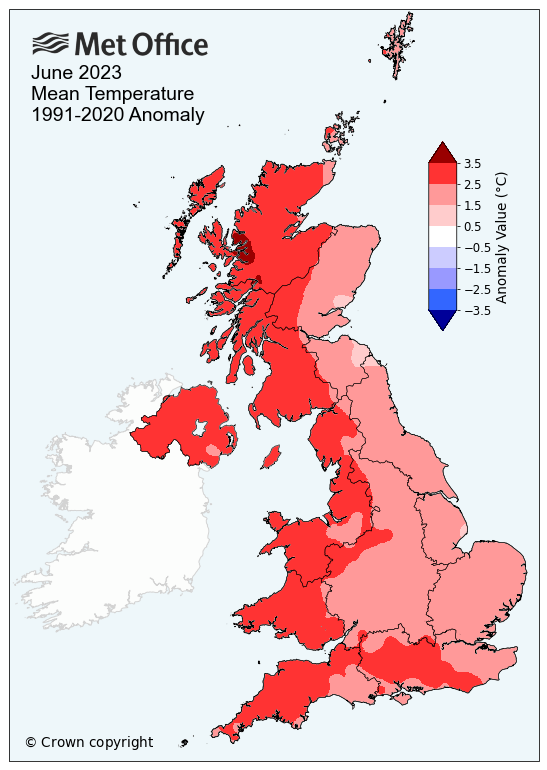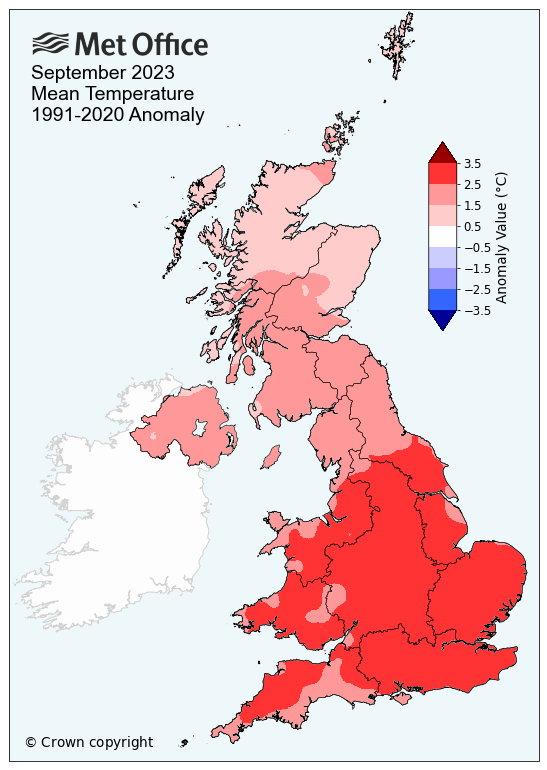With temperature and rainfall records broken, red warnings issued and a flurry of named storms, 2023 has been another eventful year of weather for the UK. While the full year’s provisional weather and climate statistics will be available on 2 January, along with the full UK State of the Climate Report later in 2024, we take a look back at the moments that defined 2023’s weather.
Our changing climate
With eight of the 12 months of the year warmer than average, 2023 will go down as one of the five warmest years on record for the UK, though the position for the full year will be announced on 2 January. This means the five warmest years in the UK series from 1884 include 2020, 2022 and 2023 – an indication of just how fast our climate continues to change.
As well as being much warmer than average, it has been a wetter than average year for most areas except western Scotland while for England and Northern Ireland this will be one of the ten wettest years on record in a series from 1836. Some areas have seen more than a quarter more rainfall than normal.
Met Office Senior Scientist Mike Kendon said: “The UK’s highly variable weather means that every year is different. However, there are clearly some common themes: firstly, our climate is continuing to change dramatically – 2023 has been yet another very warm year, as well as wetter than average – and we expect this to continue in future decades. Secondly, we have broken a number of high temperature and rainfall records over the year, and this pattern is also consistent with our changing climate. Finally, as with every year, we have seen some extreme and impactful weather, particularly the run of named storms through the Autumn and in December.
“2023 will be one of the five warmest years on record for the UK, although its exact position in the provisional figures will be confirmed in the new year.”
Record breaking June
The lion’s share of warm, dry, settled, sunny weather during the summer occurred in June – this being the warmest summer month (the last time this occurred was in 1966). Temperatures exceeded 30°C in the UK on five days in June, only one in July and none at all in August, with the highest summer maximum a modest 32.2°C compared to last year’s unprecedented 40.3°C.
June 2023 was confirmed as the hottest June on record for the UK, something that was made more likely due to climate change, according to a Met Office attribution study.
The average mean temperature of 15.8°C in the month eclipsed the previous record for the Junes of 1940 and 1976 by 0.9°C, a huge margin. The UK monthly mean temperature was 2.5°C above the 1991-2020 average, this being the highest monthly anomaly since December 2015. Met Office scientists found that the chances of surpassing the previous record of 14.9°C had more than doubled since the period around 1940 due to human-induced climate change.

September warmth
Unusually, the two most prolonged spells of fine weather occurred in June and September, separated by rather unsettled weather in July and August, including two named storms.
The early September heatwave saw temperatures exceeding 30°C somewhere in the UK for a run of seven consecutive days, a UK record. This resulted in the UK’s joint-warmest September on record for the UK – and the warmest for England and Wales – in series which go back to 1884.
Temperatures peaked at 33.5°C at Faversham on 10 September, in what was the highest temperature recorded in the UK in 2023 – only the fifth time this has occurred in September in observational records.

A change in wet weather
With the UK’s sixth wettest March, sixth wettest July and equal sixth wettest October on record in series from 1836, overall this has been a wet year for most areas.

At the start of 2023, following the recording breaking warmth and relative lack of rainfall in 2022, water scarcity and drought were in the headlines. Through 2023, rainfall amounts were tracking relatively close to average, with drier spells in February and June compensated for by wet weather in March and July. Autumn rainfall has brought rainfall amounts to above average for most of the UK, following some notable and impactful rain, especially in the east of Scotland.
Eastern Scotland had its wettest October on record, chiefly led by the exceptional rainfall brought on by Storm Babet.
Storms named… eventually
Storms have been named by the Met Office since 2015 in a joint initiative between the Met Office, Met Eireann and KNMI (the Irish and Dutch national weather services), to better communicate warnings of severe weather. For the 2022/23 season (from September 2022 to August 2023), the first storm to be named by the group happened in August 2023 – the longest wait since storm naming was introduced in the UK. However, Storms Otto and Noa, which were named by other storm naming groups, did impact the UK earlier in the year.
Seven storms have been named by the Met Office’s group since 1 September, the fastest start to a storm naming season since it began in 2015, with the run of seven storms including Agnes (late September), Babet (mid-October), Ciaran (start of November), Debi (mid-November), Elin and Fergus (early December) and Gerrit (late December).
Storm Babet occurred during a prolonged period of very wet, unsettled weather and shortly after Scotland’s wettest 2-day period on record on 6 to 7 October. Two red warnings for rain were issued by the Met Office, covering parts of eastern Scotland. For the county of Angus – coinciding with a red warning area – 19 October 2023 was, by a wide margin, the wettest day on record in a series from 1891. Babet caused widespread, extensive and severe flooding in many areas of all four nations.
2023 had several cold snaps, in the second half of January, early March and early December, with hard frosts and snow causing significant disruption at times (for example -16.0°C at Altnaharra, Sutherland on 9th March and 32cm at Buxton in Derbyshire on 10th March).
2023 also had an official White Christmas, which is defined as one snowflake falling in the UK on 25 December, though this was confined largely to high ground in the north of Scotland.
Seasons in review
Winter 2023 was drier, sunnier and slightly milder than average, with February particularly dry across England and Wales.
Spring 2023 brought into focus the shifting rainfall patterns around the UK; March was very wet in the south, in contrast May was drier than average in the north and west.
Summer 2023 was warmer and wetter than average with a record-breaking June.
Autumn 2023 was milder and wetter than average, with a fine start, a very wet October and a run of named storms.
December 2023 and the whole year’s provisional stats will be published on 2 January, with the full UK State of the Climate Report planned to be released later in 2024.


